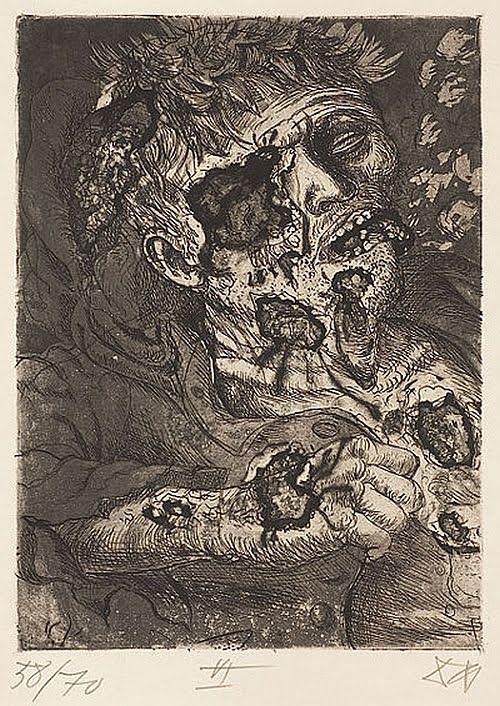Art and the Great War
World War I, or the Great War, as it was know at the time was a war unlike any other in world history to up to that time. Nearly every country in mainland Europe became a battleground. 60 million Europeans served in the military. 8.5 to 10.5 million soldiers and more than 2 million civilians died from military action and genocidal war crimes. Another 5-6 million civilians died as a result of malnutrition and disease directly caused by the war. 22 to 23 million soldiers were wounded.
16 to 27% of the entire Serbian population died, 13 to 15% of the Ottoman Empire’s and more than 4% of both Germany and France. In France another 10% of the population was wounded. If you compared France’s total deaths and wounded to today’s United States population it would be like having 13 million Americans killed and 34 million wounded as a result of the war.
A conflict this large and involving the cultural and economic heart of the western civilization had to have had a profound effect on how artists understood the world and what they chose to think about as artists.

The Dying Soldier – Etching; 1924; Berlin; 18 9/16 in. x 13 9/16 in.
Otto Dix was a German painter and print maker. Early in his career his paintings could be considered expressionistic, and he was influenced by Dada movement. He was especially known as a member of the New Objectivity movement in Germany following World War One. He served as a machine gunner in German army for four years and was seriously wounded more than once. He suffered for at least ten years from what we would now consider post-traumatic stress disorder, at the time called shell shock.
Between 1923 and 1924 he completed a collection 50 prints called The War. The portfolio of etchings is gruesome and honest but not photo realistic. They don’t glorify or make heroic what happened, they focus on its horrors. One of the etchings is A Dying Soldier. I first noticed how the lighting in the etch is on the areas of the soldier’s terrible wounds: an eye and portion of cheek bone missing; entry and exit wounds through the soldier’s chin and jaw; injuries to his upper chest, forearm and wrist; and what may be a flap of scalp and/or leaking brain from his skull. To add to the ugliness I remember the title is A Dying Soldier. He’s not dead yet, and he’s suffering until he does.
 We are Making a New World – oil; 1918; England; 28 x 36 in.
We are Making a New World – oil; 1918; England; 28 x 36 in.
Another painter who experienced the war was the British Paul Nash. His We are Making a New World also shows the horrors of the war, but in this case in a landscape. The oil painting is 28” by 30” and shows a morning sun rising over a treeless hills in background. The sun lights a devastated landscape in the foreground. There is no life visible, only a pus green shelled land, stagnant water and black, limbless remains of shelled trees.
I also notice the straight lines Nash shows the suns rays creating. They’re the only ones in the painting. It highlights the difference between the light and what the light is exposing – a dead landscape. The painting’s title is a response to a the pro-war believe that something new and better would result from it.

Gassed – oil; March 1919; England; 7 ft 6.9 in × 20 ft 0.6 in
American John Singer Sargent’s Gassed is a huge seven and half by twenty foot oil painting completed in England just following the war. It shows nine blinded men being led to an off scene medical tent by two orderlies. The guy lines from this tent are the only strait lines in the painting. In the distance another group of blind men in coming in too and the foreground is littered with wounded and either sleeping or dead men.
The entire painting is shown in a ghastly yellow light. I think it would of brought mustard gas to mind in the viewers. The nine blinded men tromp through the mud holding on to the man in front. It reminds me of Bruegel’s The Blind Leading the Blind, a painting I enjoyed in an earlier blog post. There is a realism in both that is similar too and unlike what we saw in the previous paintings. However Sargent’s painting is not photo realistic.
All three of these paintings express truths about the war experienced by the painters themselves. All three are representational art, and are not abstract. However, they are not photographically precise and are still able to evoke emotion in the viewer. I’m sure emotions were evoked in the painters as well as they found inspiration for the paintings in terrible memories.
Works Cited
Cordon, Gerry. “Otto Dix’s War: unflinching and disturbing, but dedicated to truth.” That’s How the Light Gets in. 18 Aug. 2014, https://gerryco23.wordpress.com/2014/08/18/otto-dixs-war-unflinching-and-disturbing-but-dedicated-to-truth/ Accessed 29 Oct. 2016
Cordon, Gerry. “Paul Nash and World War One: ‘I am no longer an artist, I am a messenger to those who want the war to go on forever…and may it burn their lousy souls’” That’s How the Light Gets In. 18 Feb. 2014, https://gerryco23.wordpress.com/2014/02/18/paul-nash-and-world-war-one-i-am-no-longer-an-artist-i-am-a-messenger-to-those-who-want-the-war-to-go-on-for-ever-and-may-it-burn-their-lousy-souls/ Accessed 30 Oct. 2016
“Expressionist Depictions of War.” MoMA Learning, https://www.moma.org/learn/moma_learning/themes/dada Accessed 30 Oct. 2016
Glover, Michael. “Great Works: Gassed (1919) by John Singer Sargent.” The Independent, 31 May, 2013, http://www.independent.co.uk/arts-entertainment/art/great-works/great-works-gassed-1919-by-john-singer-sargent-8637923.html Accessed 30, Oct. 2016
“Otto Dix: German Painter and Printmaker.” The Art Story, http://www.theartstory.org/artist-dix-otto.htm Accessed 31 Oct. 2016
“Paul Nash: Modern artist, ancient landscape: Room Guide: World War I.” TATE, http://www.tate.org.uk/whats-on/tate-liverpool/exhibition/paul-nash/paul-nash-modern-artist-ancient-landscape-room-guide-0 Accessed 30 Oct. 2016
“World War I.” Wikipedia, 28 Oct. 2016, https://en.wikipedia.org/wiki/World_War_I#Rape_of_Belgium Accessed 29 Oct. 2016
“World War I casualties.” Wikipedia, 26 Oct. 2016, https://en.wikipedia.org/wiki/World_War_I_casualties Accessed 30 Oct. 2016

I enjoyed your factual introduction paragraphs, and the transition to how these facts affected the way artists portrayed the world around them. It can be seen in Otto Dix’s The War collection. Especially in The Dying Soldier, horrific emotions of pain and suffering can be seen in this piece. In Paul Nash’s We are Making a New World, you can see that the land is destroyed by a horrible war. But it shows, in my opinion, that sometimes in order to build we must first destroy. John Singer Sargent’s Gassed showed us the tragedy of a war to a human being. No soldier comes home the same. Occasionally, paintings can definitely have more emotion than photos, because we are seeing what the artists saw in their mind, plus our own interpretation.
LikeLike
You provided an wealth of information that detailed the devastating loss of life resulting from World War 1. Somehow when numbers are given to represent loss of life, it makes war very real to those who haven’t experienced it. Each art choice reflects the influence of World War 1. The piece that really struck me was We Are Making a New World. It highlights the desolation that results from war. I guess it portrays a long term effect of continued destruction. As you pointed out, no life is visible. We expect people to die during war, but often the environment is not a focal point when discussing the horrors of war. It shows that war impacts not only those directly involved in war, but also affects everyone indirectly by creating an environment insufficient for mankind to thrive in. It also makes me wonder exactly how we are impacting our world today, as far as energy consumption is concerned. With a renewed consciousness, we can perhaps impact our world positively. Thanks for sharing.
LikeLike
I was interested in reading through your blog and looking at the artwork you featured because I didn’t feature World War I in my Early Modern Era Blog. I thought that you provided a great introduction to your piece by offering information on World War I and the impact that the war had on particular populations of people in Europe and the terrible manners in which they lost their lives or were injured. I agree that there is no doubt that the war evoked terrible memories and feelings of loss that is portrayed in each of your pictures in different manners. The dying soldier being the most graphic and disturbing for me to view. I don’t like the feelings that war and loss bring so I tend to enjoy artwork that provokes positive feelings or memories over pieces that invoke thoughts or feelings about death and loss. I took a look at Otto Dix’s paintings and found a painting title “Sunrise” an oil painting on paper that Otto Dix completed in 1913 and was influenced by Vincent van Gogh. I liked it because it didn’t feature men at war but it did still feature dark colors and ravens that lend you to think of darkness which is ironic with the sun featured in the middle of the paining too.
http://www.ottodix.org/catalog-paintings/
I also wanted to say this is my first time viewing your page and I really liked the main picture you have featured on your blog. The children look to be having such a wonderful time and I love the variety of beautiful kuspuks they are wearing as well. : )
LikeLike